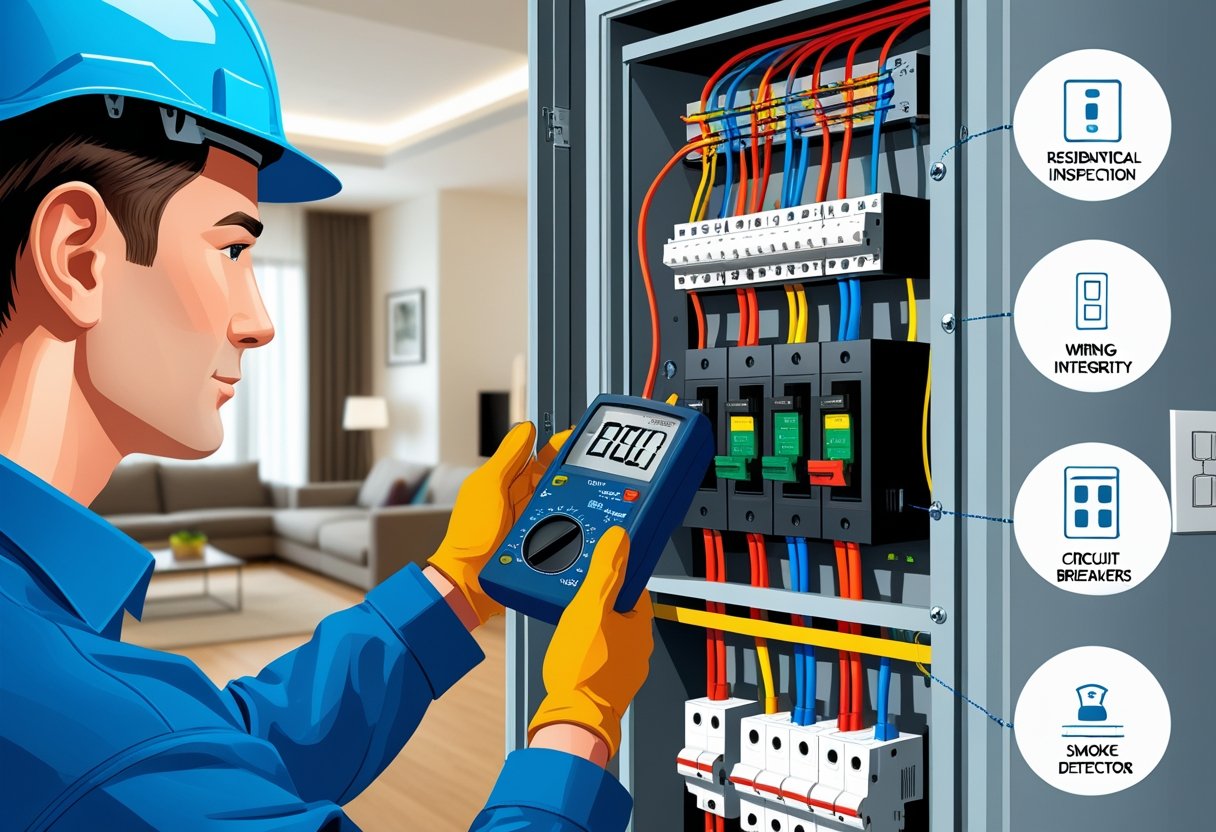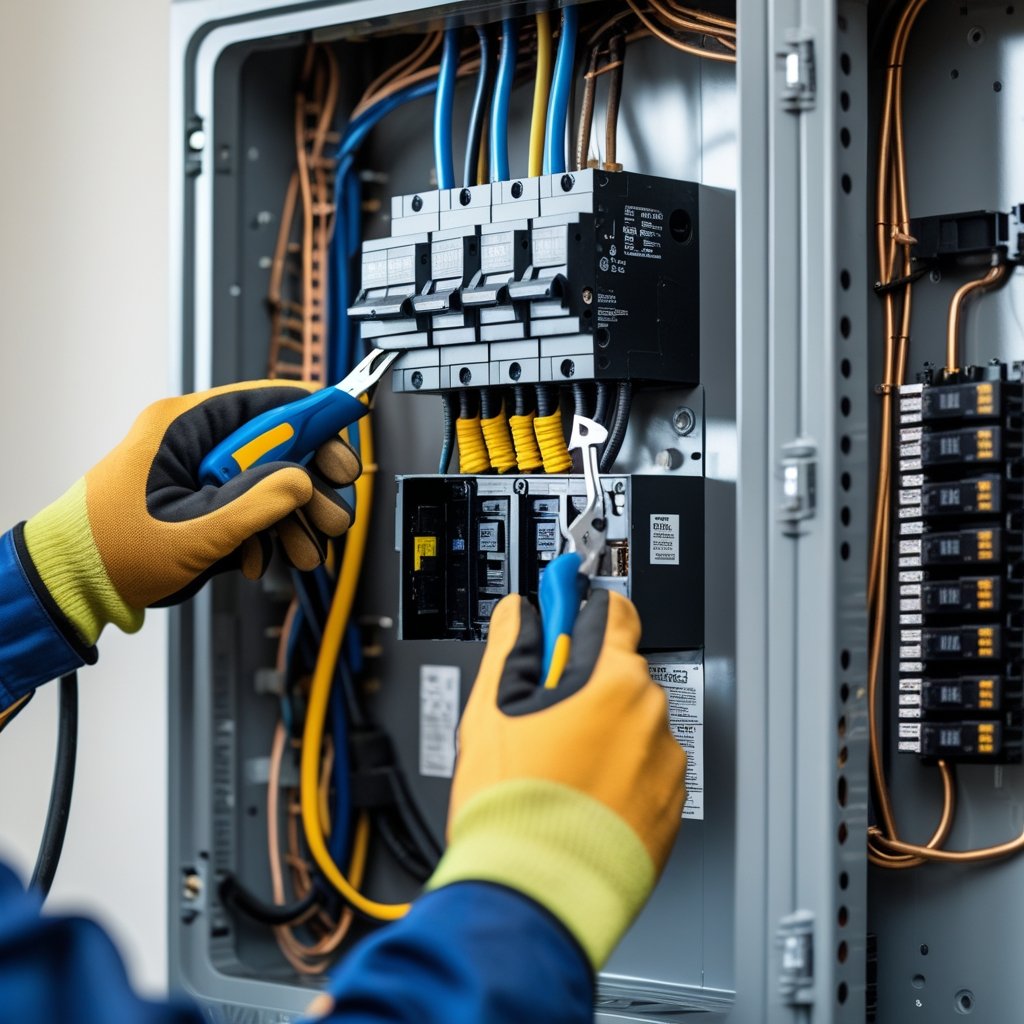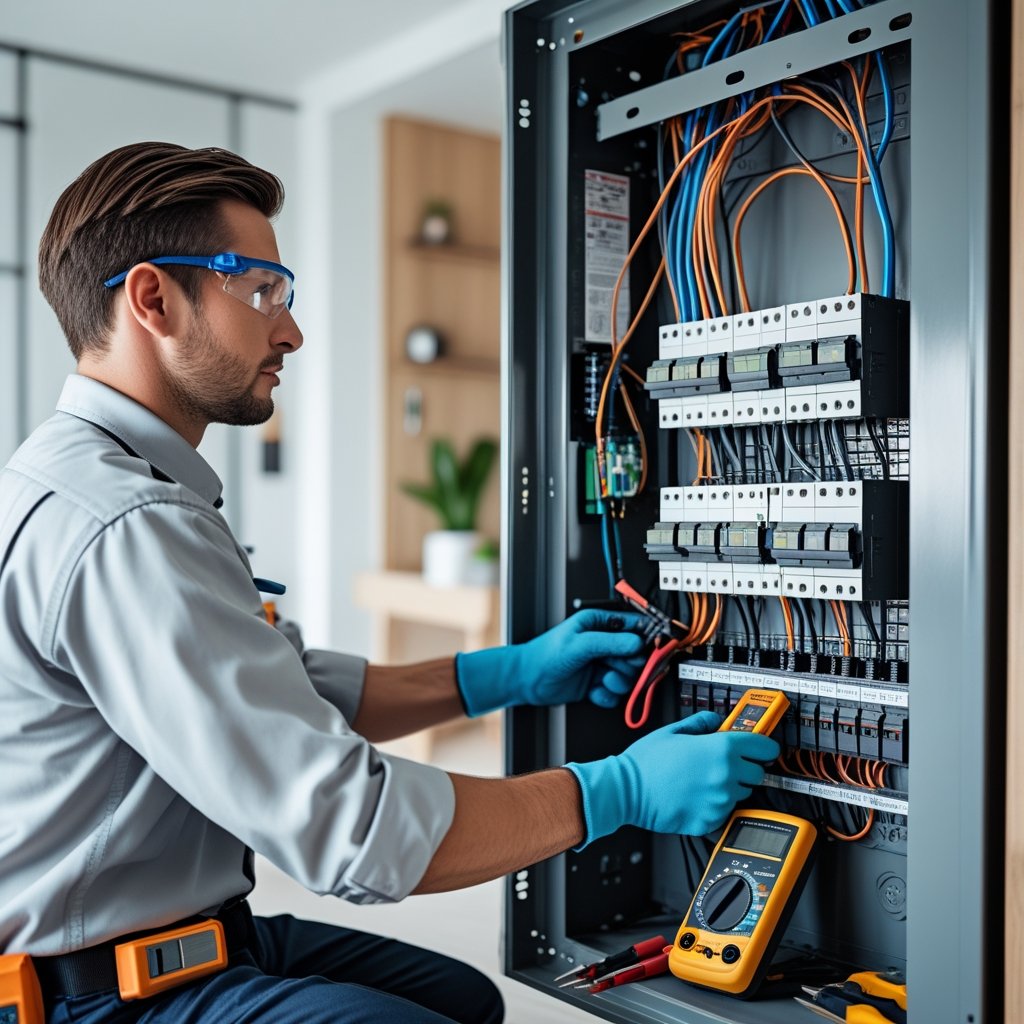A residential electrical inspection checklist helps you systematically evaluate your home's electrical system to ensure safety and compliance with current standards. Using a detailed checklist allows you to identify potential hazards, faulty wiring, and outdated equipment before they become serious problems. This proactive approach protects your family and property by preventing electrical failures and reducing fire risks.
For homeowners in Sacramento and nearby areas, AAA Electrical Services provides tailored assistance with thorough inspections performed by licensed, state-certified technicians. With same-day service and transparent flat-rate pricing, you can trust your electrical system is in capable hands, minimizing surprises and maximizing peace of mind.
Whether you’re preparing for a home sale, upgrading your panel, or simply maintaining safety, having a clear checklist keeps the process organized and effective. By following a comprehensive inspection plan, you address key components like circuit breakers, outlets, and lighting fixtures, ensuring your home meets safety standards and keeps your family secure.
Residential Electrical Inspection Checklist Overview
Understanding the detailed steps involved in inspecting your home’s electrical system helps protect your family and property. A thorough inspection ensures the system meets safety standards, functions properly, and identifies potential hazards before they cause problems.
Purpose and Importance
A residential electrical inspection checklist guides you through evaluating key components such as wiring, outlets, switches, breakers, and grounding systems. Its primary goal is to ensure these parts operate safely and effectively, minimizing risks like electrical fires or shocks.
Regular inspections help detect wear, outdated equipment, or faulty installations early. This proactive approach protects your home’s occupants and maintains system reliability, preventing costly repairs later. Using such a checklist is essential for homes in Sacramento and nearby areas, especially if your electrical system is older or recently modified.
Compliance With NEC Standards
The National Electrical Code (NEC) sets standardized safety guidelines for residential systems. Your inspection checklist should align with these requirements to verify compliance and reduce hazards.
Key NEC standards cover proper wire sizing, circuit protection, grounding, and installation methods. For example, it ensures that multiwire branch circuits and small-appliance circuits are installed correctly. Adhering to NEC standards means the system meets modern safety benchmarks and reduces liability issues during home sales or renovations.
AAA Electrical Services emphasizes NEC compliance to deliver safety-first electrical work done by licensed professionals, giving you peace of mind throughout the Greater Sacramento region.
Who Should Perform Inspections
Electrical inspections require trained, certified professionals who understand both local codes and NEC requirements. Attempting to inspect or repair your home’s electrical system yourself could miss crucial dangers or violate regulations.
You should hire licensed electricians with proven experience in residential inspections, like AAA Electrical Services technicians. Their expertise ensures an accurate assessment, identifies hidden problems, and provides honest, transparent pricing with no surprises. Their “warehouse on wheels” model means many repairs happen the same day, minimizing disruption to your home.
Choosing qualified experts protects your family’s safety and preserves the value and functionality of your home’s electrical system.
Key Elements of a Residential Electrical Inspection
A thorough residential electrical inspection focuses on verifying documentation, assessing the condition of electrical components, testing safety features, and examining wiring systems. Each area requires careful attention to identify potential electrical faults and ensure overall electrical safety in your home.
General Information and Documentation
Start by gathering all relevant documentation, such as electrical permits, previous inspection reports, and wiring diagrams. This information helps establish a baseline for the inspection and ensures that work was done according to local building codes.
You should verify the age and capacity of your electrical system, including the main panel’s amperage rating. Knowing whether the home has had recent upgrades or additions can highlight areas needing extra scrutiny.
Keep a detailed record of the electrical devices installed, including circuit breakers and outlets, which supports thorough assessment during the inspection.
Component Condition Assessment
Inspect every electrical device for physical damage, wear, or corrosion. Check circuit breakers, fuses, outlets, switches, and panels for signs of overheating, rust, or loose connections.
You want to ensure circuit breakers trip properly to protect wiring from overloads. Defective breakers or worn components can lead to electrical faults or fire hazards.
Look for outdated equipment such as knob-and-tube wiring or two-prong outlets, which typically require replacement for modern safety standards.
Safety Feature Verification
Confirm that key safety devices like Ground Fault Circuit Interrupters (GFCIs) and Arc Fault Circuit Interrupters (AFCIs) are installed where required, particularly in wet or high-risk areas.
Test these devices to ensure they function correctly by tripping under fault conditions. Proper grounding and bonding of the system must be verified to prevent electrical shock.
Smoke detectors and surge protectors are also critical safety elements to check, as they contribute to the overall protection of your home’s electrical system.
Wiring and Connections Examination
Examine all visible wiring, focusing on routing, insulation condition, and secure connections. Look for frayed or bent wires, exposed conductors, and junction boxes without covers.
Verify that wiring methods suit the environment—for example, outdoor wiring should be weather-resistant. Improper or damaged wiring is a leading cause of electrical faults.
Ensure that all splices are contained in approved electrical boxes with proper connectors to prevent short circuits.
For a detailed, professional approach to your electrical inspection needs, AAA Electrical Services offers safety-first electrical work done by licensed professionals across Sacramento and surrounding communities. You can depend on same-day service, honest pricing, and expertly stocked vans for faster fixes tailored with your family’s safety in mind. Find a comprehensive electrical inspection checklist that covers all these crucial points at residential electrical inspection checklist templates.
Room-by-Room Inspection Tasks
A thorough residential electrical inspection involves examining specific areas of your home where electrical systems face different demands and potential risks. Each room requires targeted checks to ensure wiring, outlets, and devices comply with safety standards and function correctly.
Kitchen Electrical Systems
In the kitchen, you should focus on outlets near water sources that must be GFCI (Ground Fault Circuit Interrupter) protected to prevent shocks. Inspect all outlets, switches, and appliances for proper grounding.
Check wiring methods used behind major appliances like refrigerators, ovens, and dishwashers to ensure they match code requirements and avoid overheating or faults. Look for signs of damage or wear, such as exposed wires or burned outlets.
Inspect lighting fixtures and switches for secure installation and proper operation. Consider arc fault circuit interrupters (AFCIs) if your kitchen layout or local codes require them to enhance fire prevention.
Bathroom Safety Checks
Bathrooms need careful attention due to moisture and electrical hazards. Confirm that all outlets in this area have GFCI protection. This is mandatory around sinks, tubs, and showers to reduce electrical shock risks.
Test all light fixtures, exhaust fans, and switches to verify functionality and condition, ensuring they meet current code guidelines. Check wiring insulation and outlet covers for signs of corrosion or damage from humidity.
During a rough inspection, verify that wiring routes avoid areas prone to water exposure or improper bends that can stress cables. Circuit breakers should be rated correctly for bathroom loads.
Living Areas and Bedrooms
In living spaces and bedrooms, outlets should include AFCI protection to reduce fire hazards from electrical arcs. Check for sufficient number and placement of outlets to prevent overloading.
Inspect lighting fixtures, ceiling fans, and switches for correct operation, secure mounting, and wiring integrity. Look for any signs of overheating or loose connections in receptacles and switches.
Ensure all smoke detectors and carbon monoxide alarms are wired correctly and powered, as part of a safe electrical system supporting your family’s well-being. Verify that circuits are properly labeled on your panel for easy identification.
Basements, Garages, and Outdoors
Basements and garages require GFCI outlets due to damp conditions. Along with this, inspect wiring routes to avoid damage from mechanical or moisture exposure.
In outdoor areas, outlets must have weatherproof covers and GFCI protection. Check for corrosion on fixtures and signs of water intrusion that could damage wiring.
Outdoor lighting and circuits, including those for security systems or landscape lighting, should comply with local codes and function reliably. Regular inspection helps prevent electrical failures in these high-risk areas.
For thorough and safe electrical inspections covering all these areas, AAA Electrical Services delivers safety-first electrical work done by licensed professionals in Sacramento and surrounding communities. Their stocked vans enable same-day service with honest pricing and transparent communication, keeping your family’s safety and peace of mind a top priority. For detailed checklists and tailored service, consider contacting AAA Electrical Services.
Using Electrical Inspection Checklist Templates
Using an electrical inspection checklist template helps ensure no critical steps are overlooked during your home’s inspection. These templates improve efficiency and consistency while making it easier to document findings clearly and systematically.
Benefits of Digital Templates
Digital electrical inspection checklist templates offer convenience and flexibility. You can access them from phones, tablets, or laptops, making inspections more efficient whether you're onsite or offsite.
Templates often include interactive fields, allowing you to quickly mark items as pass, fail, or requiring follow-up. This reduces manual errors and speeds up reporting. You can also customize templates to fit your specific home or service needs.
Using a digital checklist enables real-time sharing with your electrician or inspection team, improving communication. Digital records are easier to store, back up, and retrieve compared to paper forms. Many professionals in the Sacramento area, including AAA Electrical Services, rely on digital checklists to maintain detailed, organized inspection logs.
How to Choose a Checklist Format
Selecting the right electrical inspection checklist format depends on your inspection needs and technical comfort level. Templates typically come in PDF, Word, or digital app formats.
If you prefer printing and writing by hand, a clear, well-structured PDF or Word template is suitable. Look for templates that categorize tasks—such as outlets, circuit breakers, lighting, and panel inspection—to keep your review organized.
For those comfortable with technology, apps with customizable checklist features and cloud storage can streamline documentation and improve accessibility. Consider formats that comply with NEC (National Electrical Code) standards to ensure safety benchmarks are met.
Ensure the checklist matches your home’s electrical complexity and includes sections relevant to your equipment, such as EV chargers or surge protection devices, common offerings from AAA Electrical Services supporting family safety.
Documentation and Record-Keeping
Accurate documentation during your electrical inspection protects your home and investment. Use the checklist to note all observations, including pass/fail status and any needed repairs or upgrades.
Keep copies of completed checklists organized by date and property to track changes or recurring issues. Digital checklists simplify this process by enabling searchable, time-stamped records.
Well-kept records are essential if you sell your home, require warranty service, or need to validate insurance claims. They also help electricians diagnose issues faster during future visits.
AAA Electrical Services emphasizes thorough documentation as part of their electrical inspections in the Sacramento region, helping you maintain a safe and code-compliant home with clear, transparent inspection records.
For more detailed templates, you can explore options like this residential electrical inspection checklist template.
Addressing Common Electrical Issues
Understanding the most frequent electrical problems and how to manage them helps maintain a safe home environment. Regular attention to wiring, circuits, and devices reduces risks and avoids costly repairs.
Identifying Electrical Faults
Common faults include overloaded circuits, damaged wiring, and malfunctioning breakers. Look for flickering lights, frequent breaker trips, and outlets that feel hot or show burn marks.
Faulty wiring can cause shorts or sparks, increasing fire hazards. Check for loose connections behind switches and outlets. A professional inspection can pinpoint hidden problems before they worsen.
Your circuit breaker should reset without issues. If it doesn’t, or if breakers trip often, it signals electrical faults that need repair. Early identification is crucial for safety and preventing damage to appliances and wiring.
Preventive Maintenance Strategies
Regular maintenance helps avoid sudden failures and hazards. Schedule annual electrical inspections to check panels, breakers, grounding, and wiring integrity.
Replace outdated components like old panels or worn outlets promptly. Use surge protectors to shield sensitive devices. Keep electrical boxes free from dust and moisture.
AAA Electrical Services offers fast diagnosis and repairs with fully stocked vans for same-day fixes in Sacramento and surrounding areas. Their team ensures your system stays reliable and safe, minimizing risks over time.
Ensuring Ongoing Electrical Safety
Consistent vigilance maintains your home’s electrical safety. Test smoke and carbon monoxide detectors regularly and replace batteries as needed.
Avoid DIY electrical repairs unless you are certified. Always hire licensed professionals who follow current safety codes and standards.
Make sure your electrical system is properly grounded and that all circuit breakers function correctly. Keep a record of inspections and repairs to track your home’s safety history and schedule future maintenance effectively.
Frequently Asked Questions
Understanding what an electrical inspection covers, the costs involved, and what is required for final approval can help you prepare effectively. Knowing how often to schedule inspections and what common items are checked ensures your home stays safe and compliant with electrical codes.
What does an electrical inspection include?
An electrical inspection evaluates the condition of wiring, outlets, switches, and the main service panel. Inspectors check for hazards like outdated wiring, improper grounding, and overloaded circuits to ensure everything operates safely.
Safety devices such as circuit breakers and GFCIs are also tested for proper functionality. This thorough review helps prevent fire risks and electrical failures.
How much is a residential electrical inspection?
The cost of a residential electrical inspection varies by location and complexity but typically ranges between $150 and $350. Some providers, like AAA Electrical Services, offer transparent, flat-rate pricing with no surprises, giving you peace of mind upfront.
Additional repairs or upgrades discovered during the inspection may incur extra charges, which should be clearly communicated before work begins.
What is required for a final electrical inspection?
A final electrical inspection verifies that all electrical work complies with local codes and safety standards. It usually requires completing all wiring, installing fixtures, and ensuring the service panel and circuits are functioning correctly.
You must provide access to all electrical components and ensure that all permits are finalized. Passing this inspection is essential before occupying a new or remodeled home.
Do home inspectors look at electrical?
Yes, home inspectors typically include electrical systems in their evaluations. They assess wiring, outlets, breaker panels, and safety features to identify obvious defects or hazards.
However, for detailed analysis, hiring a licensed electrician or a specialized electrical inspection service like AAA Electrical Services is recommended for thorough safety assessments.
What are the common items checked during a residential electrical inspection?
Inspectors commonly check the condition of wiring, outlets, switches, grounding systems, and circuit breakers. They also test for proper circuit protection and evaluate the main service panel for signs of damage or overloading.
Safety devices like smoke detectors and GFCIs in wet areas are tested to confirm functionality. Inspecting these items helps maintain your family’s safety in the home.
How often should a residential electrical inspection be conducted?
It is recommended to have your electrical system inspected every 3 to 5 years, or more frequently if your home is older or if you notice electrical issues such as flickering lights or tripped breakers.
Regular inspections prevent hazards from developing unnoticed. Scheduling periodic checks with licensed professionals ensures your system remains safe and efficient.





